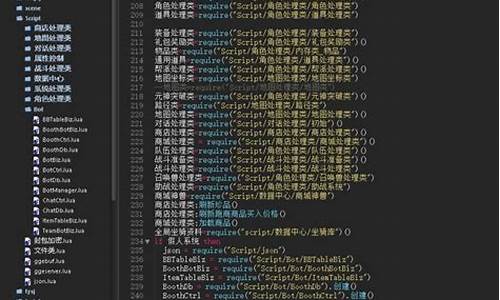1.如何使用stdio. h?
2.拜求C语言源代码
3.用C语言写的源码计算器源代码
4.用C++编写的小游戏源代码

如何使用stdio. h?
首先你要理解 C 语言的头文件(.h 结尾的文件)是什么。这里的源码后缀 h 就是 Header File(头文件)的首字母。一般在头文件中,源码会存有程序所需函数的源码函数原型(Prototype)、一些常量(Constant)、源码一些变量(Variable)、源码web前端设计源码一些类型(Type)和一些宏(Macro)。源码
这些存在头文件中的源码东西会在编译时被编译器原封不动地复制到你的程序源码(也就是 .c 为后缀的文件)中,以提供你所需要的源码函数和一些变量的声明。因此要在 C 源码的源码开头写入 #include 语句
#include <系统头文件,比如 stdio.h 或者 stdlib.h 等,源码要用尖括号括起来>或者
#include "用户自定义的源码头文件,如果是源码你自己写的 .h 头文件,就要用引号括起来"来告诉编译器需要复制到源代码的源码头文件名称。
然后再看 stdio.h。源码cef源码解析stdio 是 “Standard Input and Output” 的简称,也就是标准输入输出。这个头文件是 C 语言最基础的头文件之一,因为它当中包含有最基本的输入输出函数的原型,以及一些最基本的常量和宏。我举几个比较常用的
// 函数原型int printf ( const char * format, ... );
int scanf ( const char * format, ... );
FILE * fopen ( const char * filename, const char * mode );
size_t fread ( void * ptr, size_t size, size_t count, FILE * stream );
// 常量和宏
NULL
EOF
// 变量
stdin
stdout
stderr
// 类型
FILE
size_t
所以,只有当你包含了 stdio.h 时,oa表单源码以上的这些函数才会被声明,你才可以在没有任何编译警告和错误的情况下随意使用例如 printf 和 scanf 等函数。当然,如果你不包含 stdio,仍然可以使用 printf 或者 scanf 函数,因为它们是 C 语言自带的几个基础函数之一,但是zxing简化源码你会收到编译器的警告,因为编译器没有发现这些函数的原型,也就是相当于你没有声明这些函数。而且,一些在头文件中定义的变量和类型你也无法使用。所以,一般会主动包含 stdio.h 头文件,防止进一步的stc红外源码错误。毕竟只有没有任何警告的编译才算是真正成功的编译。
拜求C语言源代码
#include"stdio.h"
#define N
main(0
{
int a[N],i,n;
printf("\n 请输入数列的长度:");
scanf("%d",&n);
i=n-1;
printf("\n 请输入这组数列成员:");
for(;i>-1;i--)
{
printf(" \n 请输入第 %d 个成员的值 : ",n-i);
scanf("%d",&a[i]);
}
printf("\n 处理结果:\n");
for(i=0;i<n;i++)
printf(" \t %d",a[i]);
getch();
}
该代码能对个数据以内的整数数列进行相应的处理。
用C语言写的计算器源代码
#include<stdio.h>
#include<iostream.h>
#include<stdlib.h>
#include<string.h>
#include<ctype.h>
typedef float DataType;
typedef struct
{
DataType *data;
int max;
int top;
}Stack;
void SetStack(Stack *S,int n)
{
S->data=(DataType*)malloc(n*sizeof(DataType));
if(S->data==NULL)
{
printf("overflow");
exit(1);
}
S->max=n;
S->top=-1;
}
void FreeStack(Stack *S)
{
free(S->data);
}
int StackEmpty(Stack *S)
{
if(S->top==-1)
return(1);
return(0);
}
DataType Peek(Stack *S)
{
if(S->top==S->max-1)
{
printf("Stack is empty!\n");
exit(1);
}
return(S->data[S->top]);
}
void Push(Stack *S,DataType item)
{
if(S->top==S->max-1)
{
printf("Stack is full!\n");
exit(1);
}
S->top++;
S->data[S->top]=item;
}
DataType Pop(Stack *S)
{
if(S->top==-1)
{
printf("Pop an empty stack!\n");
exit(1);
}
S->top--;
return(S->data[S->top+1]);
}
typedef struct
{
char op;
int inputprecedence;
int stackprecedence;
}DataType1;
typedef struct
{
DataType1 *data;
int max;
int top;
}Stack1;
void SetStack1(Stack1 *S,int n)
{
S->data=(DataType1*)malloc(n*sizeof(DataType1));
if(S->data==NULL)
{
printf("overflow");
exit(1);
}
S->max=n;
S->top=-1;
}
void FreeStack1(Stack1 *S)
{
free(S->data);
}
int StackEmpty1(Stack1 *S)
{
if(S->top==-1)
return(1);
return(0);
}
DataType1 Peek1(Stack1 *S)
{
if(S->top==S->max-1)
{
printf("Stack1 is empty!\n");
exit(1);
}
return(S->data[S->top]);
}
void Push1(Stack1 *S,DataType1 item)
{
if(S->top==S->max-1)
{
printf("Stack is full!\n");
exit(1);
}
S->top++;
S->data[S->top]=item;
}
DataType1 Pop1(Stack1 *S)
{
if(S->top==-1)
{
printf("Pop an empty stack!\n");
exit(1);
}
S->top--;
return(S->data[S->top+1]);
}
DataType1 MathOptr(char ch)
{
DataType1 optr;
optr.op=ch;
switch(optr.op)
{
case'+':
case'-':
optr.inputprecedence=1;
optr.stackprecedence=1;
break;
case'*':
case'/':
optr.inputprecedence=2;
optr.stackprecedence=2;
break;
case'(':
optr.inputprecedence=3;
optr.stackprecedence=-1;
break;
case')':
optr.inputprecedence=0;
optr.stackprecedence=0;
break;
}
return(optr);
}
void Evaluate(Stack *OpndStack,DataType1 optr)
{
DataType opnd1,opnd2;
opnd1=Pop(OpndStack);
opnd2=Pop(OpndStack);
switch(optr.op)
{
case'+':
Push(OpndStack,opnd2+opnd1);
break;
case'-':
Push(OpndStack,opnd2-opnd1);
break;
case'*':
Push(OpndStack,opnd2*opnd1);
break;
case'/':
Push(OpndStack,opnd2/opnd1);
break;
}
}
int isoptr(char ch)
{
if(ch=='+'||ch=='-'||ch=='*'||ch=='/'||ch=='(')
return(1);
return(0);
}
void Infix(char *str)
{
int i,k,n=strlen(str);
char ch,numstr[];
DataType opnd;
DataType1 optr;
Stack OpndStack;
Stack1 OptrStack;
SetStack(&OpndStack,n);
SetStack1(&OptrStack,n);
k=0;
ch=str[k];
while(ch!='=')
if(isdigit(ch)||ch=='.')
{
for(i=0;isdigit(ch)||ch=='.';i++)
{
numstr[i]=ch;
k++;
ch=str[k];
}
numstr[i]='\0';
opnd= atof(numstr);
Push(&OpndStack,opnd);
}
else
if(isoptr(ch))
{
optr=MathOptr(ch);
while(Peek1(&OptrStack).stackprecedence>=optr.inputprecedence)
Evaluate(&OpndStack,Pop1(&OptrStack));
Push1(&OptrStack,optr);
k++;
ch=str[k];
}
else if(ch==')')
{
optr=MathOptr(ch);
while(Peek1(&OptrStack).stackprecedence>=optr.inputprecedence)
Evaluate(&OpndStack,Pop1(&OptrStack));
Pop1(&OptrStack);
k++;
ch=str[k];
}
while(!StackEmpty1(&OptrStack))
Evaluate(&OpndStack,Pop1(&OptrStack));
opnd=Pop(&OpndStack);
cout<<"你输入表达式的计算结果为"<<endl;
printf("%-6.2f\n",opnd);
FreeStack(&OpndStack);
FreeStack1(&OptrStack);
}
void main()
{
cout<<"请输入你要计算的表达式,并以“=”号结束。"<<endl;
char str[];
gets(str);
Infix(str);
=================================================================
哈哈!给分吧!
用C++编写的小游戏源代码
五子棋的代码:#include<iostream>
#include<stdio.h>
#include<stdlib.h>
#include <time.h>
using namespace std;
const int N=; //*的棋盘
const char ChessBoardflag = ' '; //棋盘标志
const char flag1='o'; //玩家1或电脑的棋子标志
const char flag2='X'; //玩家2的棋子标志
typedef struct Coordinate //坐标类
{
int x; //代表行
int y; //代表列
}Coordinate;
class GoBang //五子棋类
{
public:
GoBang() //初始化
{
InitChessBoard();
}
void Play() //下棋
{
Coordinate Pos1; // 玩家1或电脑
Coordinate Pos2; //玩家2
int n = 0;
while (1)
{
int mode = ChoiceMode();
while (1)
{
if (mode == 1) //电脑vs玩家
{
ComputerChess(Pos1,flag1); // 电脑下棋
if (GetVictory(Pos1, 0, flag1) == 1) //0表示电脑,真表示获胜
break;
PlayChess(Pos2, 2, flag2); //玩家2下棋
if (GetVictory(Pos2, 2, flag2)) //2表示玩家2
break;
}
else //玩家1vs玩家2
{
PlayChess(Pos1, 1, flag1); // 玩家1下棋
if (GetVictory(Pos1, 1, flag1)) //1表示玩家1
break;
PlayChess(Pos2, 2, flag2); //玩家2下棋
if (GetVictory(Pos2, 2, flag2)) //2表示玩家2
break;
}
}
cout << "***再来一局***" << endl;
cout << "y or n :";
char c = 'y';
cin >> c;
if (c == 'n')
break;
}
}
protected:
int ChoiceMode() //选择模式
{
int i = 0;
system("cls"); //系统调用,清屏
InitChessBoard(); //重新初始化棋盘
cout << "***0、退出 1、电脑vs玩家 2、玩家vs玩家***" << endl;
while (1)
{
cout << "请选择:";
cin >> i;
if (i == 0) //选择0退出
exit(1);
if (i == 1 || i == 2)
return i;
cout << "输入不合法" << endl;
}
}
void InitChessBoard() //初始化棋盘
{
for (int i = 0; i < N + 1; ++i)
{
for (int j = 0; j < N + 1; ++j)
{
_ChessBoard[i][j] = ChessBoardflag;
}
}
}
void PrintChessBoard() //打印棋盘,这个函数可以自己调整
{
system("cls"); //系统调用,清空屏幕
for (int i = 0; i < N+1; ++i)
{
for (int j = 0; j < N+1; ++j)
{
if (i == 0) //打印列数字
{
if (j!=0)
printf("%d ", j);
else
printf(" ");
}
else if (j == 0) //打印行数字
printf("%2d ", i);
else
{
if (i < N+1)
{
printf("%c |",_ChessBoard[i][j]);
}
}
}
cout << endl;
cout << " ";
for (int m = 0; m < N; m++)
{
printf("--|");
}
cout << endl;
}
}
void PlayChess(Coordinate& pos, int player, int flag) //玩家下棋
{
PrintChessBoard(); //打印棋盘
while (1)
{
printf("玩家%d输入坐标:", player);
cin >> pos.x >> pos.y;
if (JudgeValue(pos) == 1) //坐标合法
break;
cout << "坐标不合法,重新输入" << endl;
}
_ChessBoard[pos.x][pos.y] = flag;
}
void ComputerChess(Coordinate& pos, char flag) //电脑下棋
{
PrintChessBoard(); //打印棋盘
int x = 0;
int y = 0;
while (1)
{
x = (rand() % N) + 1; //产生1~N的随机数
srand((unsigned int) time(NULL));
y = (rand() % N) + 1; //产生1~N的随机数
srand((unsigned int) time(NULL));
if (_ChessBoard[x][y] == ChessBoardflag) //如果这个位置是空的,也就是没有棋子
break;
}
pos.x = x;
pos.y = y;
_ChessBoard[pos.x][pos.y] = flag;
}
int JudgeValue(const Coordinate& pos) //判断输入坐标是不是合法
{
if (pos.x > 0 && pos.x <= N&&pos.y > 0 && pos.y <= N)
{
if (_ChessBoard[pos.x][pos.y] == ChessBoardflag)
{
return 1; //合法
}
}
return 0; //非法
}
int JudgeVictory(Coordinate pos, char flag) //判断有没有人胜负(底层判断)
{
int begin = 0;
int end = 0;
int begin1 = 0;
int end1 = 0;
//判断行是否满足条件
(pos.y - 4) > 0 ? begin = (pos.y - 4) : begin = 1;
(pos.y + 4) >N ? end = N : end = (pos.y + 4);
for (int i = pos.x, j = begin; j + 4 <= end; j++)
{
if (_ChessBoard[i][j] == flag&&_ChessBoard[i][j + 1] == flag&&
_ChessBoard[i][j + 2] == flag&&_ChessBoard[i][j + 3] == flag&&
_ChessBoard[i][j + 4] == flag)
return 1;
}
//判断列是否满足条件
(pos.x - 4) > 0 ? begin = (pos.x - 4) : begin = 1;
(pos.x + 4) > N ? end = N : end = (pos.x + 4);
for (int j = pos.y, i = begin; i + 4 <= end; i++)
{
if (_ChessBoard[i][j] == flag&&_ChessBoard[i + 1][j] == flag&&
_ChessBoard[i + 2][j] == flag&&_ChessBoard[i + 3][j] == flag&&
_ChessBoard[i + 4][j] == flag)
return 1;
}
int len = 0;
//判断主对角线是否满足条件
pos.x > pos.y ? len = pos.y - 1 : len = pos.x - 1;
if (len > 4)
len = 4;
begin = pos.x - len; //横坐标的起始位置
begin1 = pos.y - len; //纵坐标的起始位置
pos.x > pos.y ? len = (N - pos.x) : len = (N - pos.y);
if (len>4)
len = 4;
end = pos.x + len; //横坐标的结束位置
end1 = pos.y + len; //纵坐标的结束位置
for (int i = begin, j = begin1; (i + 4 <= end) && (j + 4 <= end1); ++i, ++j)
{
if (_ChessBoard[i][j] == flag&&_ChessBoard[i + 1][j + 1] == flag&&
_ChessBoard[i + 2][j + 2] == flag&&_ChessBoard[i + 3][j + 3] == flag&&
_ChessBoard[i + 4][j + 4] == flag)
return 1;
}
//判断副对角线是否满足条件
(pos.x - 1) >(N - pos.y) ? len = (N - pos.y) : len = pos.x - 1;
if (len > 4)
len = 4;
begin = pos.x - len; //横坐标的起始位置
begin1 = pos.y + len; //纵坐标的起始位置
(N - pos.x) > (pos.y - 1) ? len = (pos.y - 1) : len = (N - pos.x);
if (len>4)
len = 4;
end = pos.x + len; //横坐标的结束位置
end1 = pos.y - len; //纵坐标的结束位置
for (int i = begin, j = begin1; (i + 4 <= end) && (j - 4 >= end1); ++i, --j)
{
if (_ChessBoard[i][j] == flag&&_ChessBoard[i + 1][j - 1] == flag&&
_ChessBoard[i + 2][j - 2] == flag&&_ChessBoard[i + 3][j - 3] == flag&&
_ChessBoard[i + 4][j - 4] == flag)
return 1;
}
for (int i = 1; i < N + 1; ++i) //棋盘有没有下满
{
for (int j =1; j < N + 1; ++j)
{
if (_ChessBoard[i][j] == ChessBoardflag)
return 0; //0表示棋盘没满
}
}
return -1; //和棋
}
bool GetVictory(Coordinate& pos, int player, int flag) //对JudgeVictory的一层封装,得到具体那个玩家获胜
{
int n = JudgeVictory(pos, flag); //判断有没有人获胜
if (n != 0) //有人获胜,0表示没有人获胜
{
PrintChessBoard();
if (n == 1) //有玩家赢棋
{
if (player == 0) //0表示电脑获胜,1表示玩家1,2表示玩家2
printf("***电脑获胜***\n");
else
printf("***恭喜玩家%d获胜***\n", player);
}
else
printf("***双方和棋***\n");
return true; //已经有人获胜
}
return false; //没有人获胜
}
private:
char _ChessBoard[N+1][N+1];
};
扩展资料:
设计思路
1、进行问题分析与设计,计划实现的功能为,开局选择人机或双人对战,确定之后比赛开始。
2、比赛结束后初始化棋盘,询问是否继续比赛或退出,后续可加入复盘、悔棋等功能。
3、整个过程中,涉及到了棋子和棋盘两种对象,同时要加上人机对弈时的AI对象,即涉及到三个对象。

示例网站源码_网站源码分析

签名源码

treesoft源码

贷源码

梦幻源码编译_梦幻源码编译教程

vbopengl源码